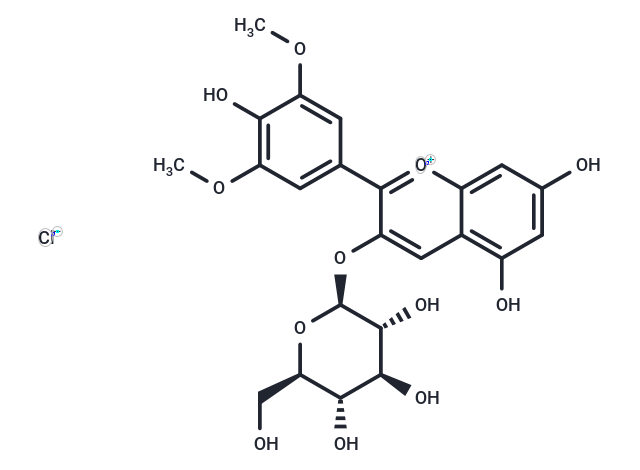Shopping Cart
- Remove All
 Your shopping cart is currently empty
Your shopping cart is currently empty

Malvidin-3-glucoside chloride (Oenin chloride) has antioxidant activity, alone is not oxidized in the presence of grape polyphenol oxidase. Malvidin-3-O-glucoside chloride's color stabilization at a higher pH can be explained by self-aggregation of the flavylium cation and copigmentation with the Z-chalcone form.

| Pack Size | Price | Availability | Quantity |
|---|---|---|---|
| 1 mg | $299 | In Stock |
| Description | Malvidin-3-glucoside chloride (Oenin chloride) has antioxidant activity, alone is not oxidized in the presence of grape polyphenol oxidase. Malvidin-3-O-glucoside chloride's color stabilization at a higher pH can be explained by self-aggregation of the flavylium cation and copigmentation with the Z-chalcone form. |
| In vitro | Here we used a gel electrophoresis assay employing supercoiled DNA plasmid to examine the ability of these compounds (1) to intercalate DNA, (2) to inhibit human topoisomerase I through both inhibition of plasmid relaxation activity (catalytic inhibition) and stabilization of the cleavable DNA-topoisomerase complex (poisoning), and (3) to inhibit or enhance oxidative single-strand DNA nicking. We found no evidence of DNA intercalation by anthocyan(id)ins in the physiological pH range for any of the compounds used in this study-cyanidin chloride, cyanidin 3-O-glucoside, cyanidin 3,5-O-diglucoside, Malvidin-3-O-glucoside chloride and luteolinidin chloride. The anthocyanins inhibited topoisomerase relaxation activity only at high concentrations (> 50 muM) and we could find no evidence of topoisomerase I cleavable complex stabilization by these compounds. |
| Alias | Oenin chloride, Malvidin-3-O-glucoside chloride |
| Molecular Weight | 528.89 |
| Formula | C23H25ClO12 |
| Cas No. | 7228-78-6 |
| Smiles | [Cl-].COc1cc(cc(OC)c1O)-c1[o+]c2cc(O)cc(O)c2cc1O[C@@H]1O[C@H](CO)[C@@H](O)[C@H](O)[C@H]1O |
| Relative Density. | no data available |
| Storage | store at low temperature,keep away from direct sunlight,keep away from moisture | Powder: -20°C for 3 years | In solvent: -80°C for 1 year | Shipping with blue ice. | |||||||||||||||||||||||||
| Solubility Information | DMF: 20 mg/mL (37.82 mM), Sonication is recommended. DMSO: 20 mg/mL (37.82 mM), Sonication is recommended. | |||||||||||||||||||||||||
Solution Preparation Table | ||||||||||||||||||||||||||
DMF/DMSO
| ||||||||||||||||||||||||||

Copyright © 2015-2025 TargetMol Chemicals Inc. All Rights Reserved.